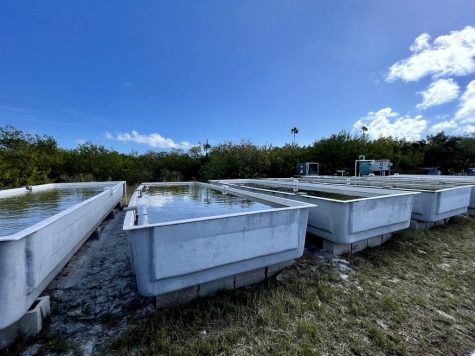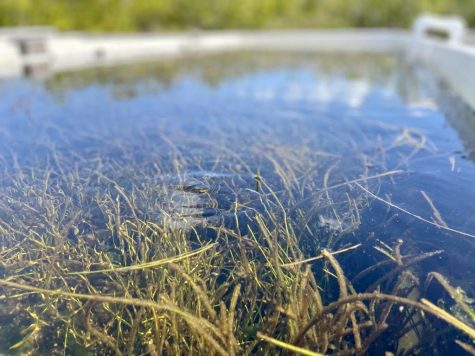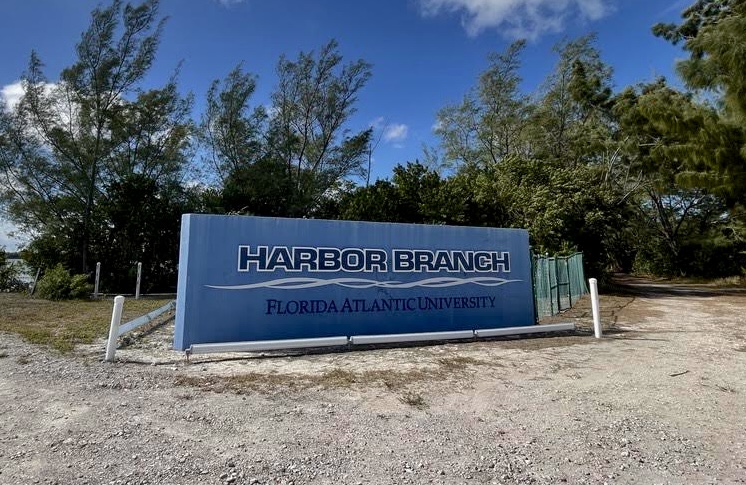HBOI: How growing seagrass can help save the manatees
Directors at Harbor Branch Oceanographic Institute focus on restoring seagrass to slow the decline in the Florida manatee population.
April 5, 2022
As Florida manatees die from starvation, researchers at FAU’s Harbor Branch Oceanographic Institute (HBOI) say one solution could be to simply grow more seagrass — so, that’s exactly what they’re attempting.
With a three-year fund from Florida Power & Light Company (FPL) as well as funding from the Florida Fish and Wildlife Conservation Commission, HBOI researchers hope to grow more seagrass and look into the causes of the loss.
At HBOI, researchers have grown seagrass in tanks and transplanted it into the Indian River Lagoon in order to help the declining seagrass population.
“We’ve lost seventy percent or so of all the grass in the entire lagoon, but in the northern lagoon there’s good areas where it’s been a hundred percent loss,” said Dennis Hanisak, director of Harbor Branch’s Marine Ecosystem Health Program.

The lagoon’s health also has an impact on the economies of nearby cities and counties. St. Lucie County communications director Erick Gill called the Indian River Lagoon a “huge” part of the county’s economy. In addition to that, the Indian River Lagoon is home to a vast range of organisms.
“It’s a living estuary,” said Gill while commenting on the lagoon. “It’s one of the most biodiverse estuaries in North America and it’s really where the tropics begin, and I think if you take out any part of that ecosystem, it’s gonna have a negative impact on another species.”
Researchers have found that the loss of seagrass — the preferred source of food for manatees, according to Hanisak — is tied to a decline in the manatee population. This decline in the seagrass population is not only occurring in Florida, however.
“What we’re seeing here is part of a global decline in seagrasses,” Hanisak said, explaining that the suddenness of the 2011 seagrass loss in the Indian River Lagoon was what highlighted that area in particular.
The causes of seagrass loss include stormwater runoff and algal blooms, and Beth Alvi, director of policy at a Miami-based advocacy group called Audubon Florida, suggested improving water quality could help seagrass restoration efforts succeed.
Hanisak explained that a small organism darkened the water, causing an unprecedented algal bloom in 2011. This algal bloom prevented light from reaching some seagrasses.
“Seagrasses have a very high light requirement,” he said. Without light, they cannot undergo photosynthesis, which puts their survival at risk.
Through a feeding program in the Indian River Lagoon, state employees from the Florida Fish and Wildlife Conservation Commission provided manatees with romaine lettuce in order to prevent starvation, according to Hanisak.
Giving manatees a temporary substitute has happened in other parts of the state as well. “The majority, by far, of what we feed is romaine lettuce,” said Craig Miller, curator of manatee conservation at the Jacksonville Zoo and Gardens.
Others acknowledged that romaine lettuce is not necessarily a long-term solution to the starvation of manatees.
“I’m glad to see something is being done,” said Alvi. ”But it’s not something that can be done long-term because of the sheer quantities of what is needed.”

Despite the loss of seagrass and its effects on our ecosystems, however, there are steps that we can take to help out.
“Holding yourself responsible for how much water you use, how you use it, how you dispose of your waste — all of those types of things contribute towards making the place better,” Alvi said.
Nathalie Vega is a contributing writer for the University Press. For more information on this article or others, you can reach Nathalie at nvperez556@gmail.com.







